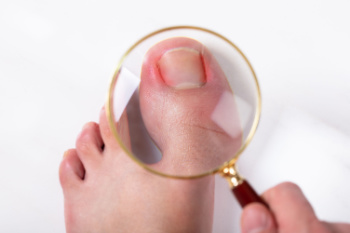
Ingrown toenails and toenail fungus are common foot issues that can lead to pain and infection if not properly treated. Ingrown toenails occur when the nail grows into the surrounding skin, often due to improper trimming, tight footwear, or injury. Symptoms include redness, swelling, tenderness, and sometimes drainage or infection. Toenail fungus, or onychomycosis, is caused by fungal organisms that thrive in warm, moist environments. It often appears as thickened, discolored, brittle, or distorted nails that may emit an unpleasant odor. Both conditions can be uncomfortable and unsightly. A podiatrist can accurately diagnose the problem through physical examination and, in the case of fungal infections, lab testing. Treatment options for ingrown nails may include trimming, lifting the nail edge, or partial nail removal. For toenail fungus, treatments can include topical or oral antifungal medications or nail debridement. To prevent worsening symptoms or complications, it is suggested that you make an appointment with a podiatrist.
Ingrown toenails may initially present themselves as a minor discomfort, but they may progress into an infection in the skin without proper treatment. For more information about ingrown toenails, contact Lawrence Fallat, DPM of Michigan. Our doctor can provide the care you need to keep you pain-free and on your feet.
Ingrown Toenails
Ingrown toenails are caused when the corner or side of a toenail grows into the soft flesh surrounding it. They often result in redness, swelling, pain, and in some cases, infection. This condition typically affects the big toe and may recur if it is not treated properly.
Causes
- Improper toenail trimming
- Genetics
- Improper shoe fitting
- Injury from pedicures or nail picking
- Abnormal gait
- Poor hygiene
You are more likely to develop an ingrown toenail if you are obese, have diabetes, arthritis, or have any fungal infection in your nails. Additionally, people who have foot or toe deformities are at a higher risk of developing an ingrown toenail.
Symptoms
Some symptoms of ingrown toenails are redness, swelling, and pain. In rare cases, there may be a yellowish drainage coming from the nail.
Treatment
Ignoring an ingrown toenail can have serious complications. Infections of the nail border can progress to a deeper soft-tissue infection, which can then turn into a bone infection. You should always speak with your podiatrist if you suspect you have an ingrown toenail, especially if you have diabetes or poor circulation.
If you have any questions, please feel free to contact our offices located in Canton and Taylor, MI . We offer the newest diagnostic and treatment technologies for all your foot care needs.
